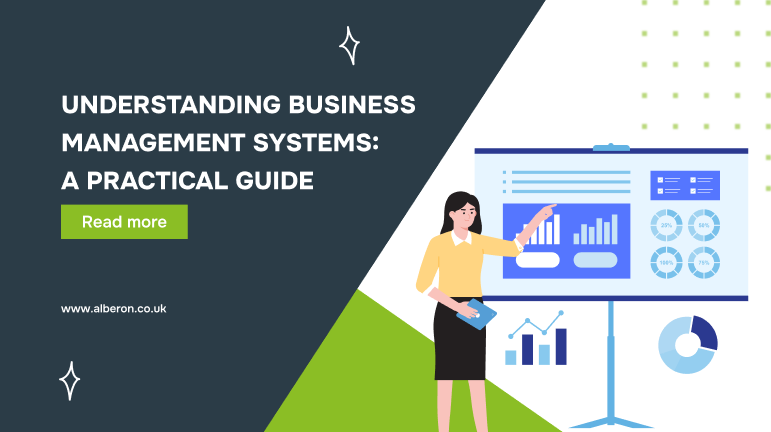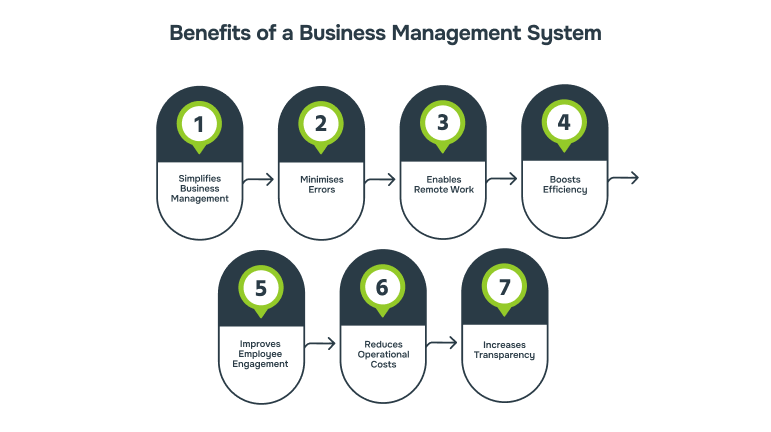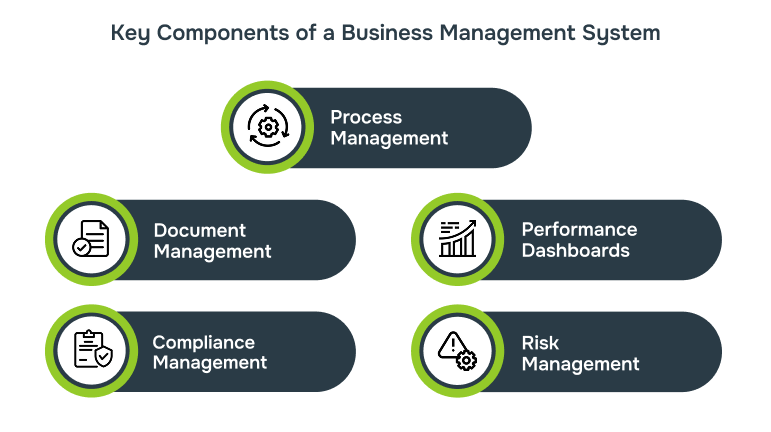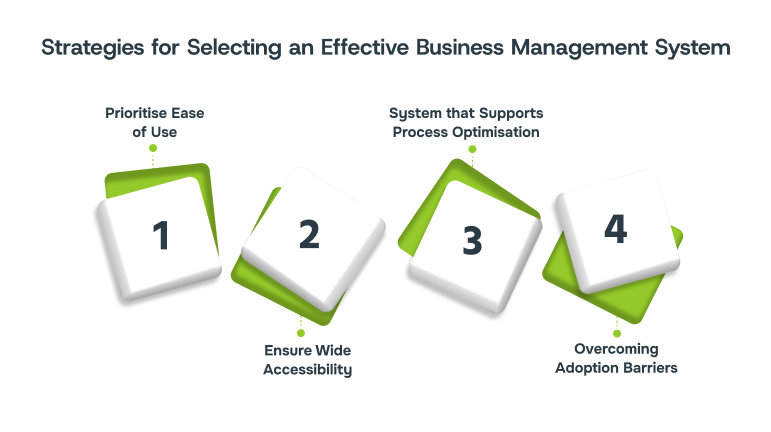Understanding Business Management Systems: A Practical Guide
Improve efficiency and decisions with the right business system. Learn key components, quality control, and risk strategies to streamline operations.

Are you looking for a smarter way to align operations across your organisation? A Business Management System (BMS) could be the solution. By streamlining processes, improving efficiency, and integrating core functions, a BMS offers a unified, real-time view of your business operations.
We understand that using outdated systems can be frustrating, especially when you’re trying to keep everything running smoothly. It’s completely normal to feel unsure about making a big change while still managing daily tasks.
In this guide, we’ll explore the key benefits of a business management system (BMS), common pain points, and how to choose the right system for your business needs.
What is a Business Management System (BMS)?
A Business Management System (BMS) is a collection of tools designed to help organisations manage and improve their operations, such as customer relationship management (CRM), enterprise resource planning (ERP), human resources (HR), finance, and project management. These systems are commonly used for planning, documenting processes, and ensuring effective execution. By integrating various business processes into one system, BMS reduces redundancies, improves accuracy, and improves decision-making.
For organisations across the UK, particularly in sectors such as manufacturing, finance, education, and non-profit, a BMS can revolutionise operations by ensuring smoother workflows, real-time data access, and greater scalability. It brings structure and consistency to how businesses operate and grow. Reflecting this growing demand, the business management software market is projected to increase by $421 billion between 2024 and 2029, with a CAGR of 12.8%.
BMS includes:
- Process Documentation: Captures best practices, procedures, and key organisational knowledge.
- Integrated Workflows: Connects departments to improve collaboration and streamline operations.
- Strategic Planning: Helps set goals and outline the roadmap for long-term growth.
- Performance Tracking: Uses data and analytics to measure success and drive ongoing improvement.
Why is a Business Management System Important?
A Business Management System (BMS) is essential for aligning people, processes, and technology to drive efficiency and consistency across an organisation. It creates a structured approach to managing operations, enabling smarter decisions and sustainable growth.
- Streamlines Operations: Centralises processes across departments, making it easier to track progress, monitor performance, and make informed decisions.
- Improves Efficiency: Automates repetitive tasks, reduces errors, and accelerates workflows, eliminating the delays caused by manual systems. For Example, an e-commerce company automates inventory updates and invoice generation through its BMS, saving hours each week that were previously spent on manual data entry, while also reducing stockouts and billing errors.
- Data-Driven Insights: Offers real-time dashboards and analytics that help teams make informed, proactive decisions based on actual performance data. For Example, A manufacturing firm uses its BMS to track equipment performance in real time. When downtime trends appear, it schedules maintenance early to cut costs and avoid delays.
- Scalable & Flexible: Adapts as your business grows, supporting market expansion, new product launches, and team growth, without sacrificing efficiency.
These advantages lay the foundation for long-term success, but the value of a BMS goes even deeper. Let’s look at the key benefits it brings to your day-to-day operations.
Benefits of a Business Management System

A Business Management System (BMS) offers a centralised way to manage and improve core business processes. By integrating key functions, it helps organisations work smarter, faster, and more efficiently.
- Simplifies Business Management: Simplifying management tasks provides a clearer overview of operations and helps ensure processes run smoothly.
- Minimises Errors: Automated workflows reduce the need for manual data entry and help eliminate errors caused by transferring information between disconnected systems. This leads to more accurate reporting and fewer costly mistakes. As per reports, companies using BPM tools report a 40% reduction in errorsand more precise decision-making
- Enables Remote Work: Cloud-based BMS platforms allow staff to securely access information and manage tasks from anywhere, ensuring consistent operations across locations.
- Boosts Efficiency: By connecting various departments through a centralised platform, a BMS allows employees to complete tasks faster and collaborate more effectively. Cross-functional processes become easier to manage, reducing delays and duplication of work.
- Improves Employee Engagement: Clearly defined processes and goals empower employees to work with confidence. When staff understand their roles and see how their work contributes to broader objectives, it improves motivation and job satisfaction.
- Reduces Operational Costs: Instead of juggling multiple software tools for different functions, a BMS consolidates them into one system. This not only saves money on software licenses but also improves overall resource efficiency.
- Increases Transparency: BMS platforms help share strategic goals across the business. By linking everyday tasks to high-level objectives, employees gain a better understanding of their impact, fostering a culture of accountability and clarity.
Now that we’ve covered the benefits, it’s helpful to understand what makes up a strong Business Management System. Below are the key components that drive its success.
Key Components of a Business Management System

A Business Management System (BMS) is built on several core components that work together to streamline operations, improve decision-making, and ensure long-term success. Below are the essential elements that make up an effective BMS.
1. Process Management
- Core Functionality: Process management is the foundation of a BMS, ensuring business operations are well-structured, efficient, and adaptable. It involves carefully mapping out each step, understanding how processes connect, and anticipating possible bottlenecks.
- Operational Optimisation: More than just mapping, it focuses on refining workflows to increase efficiency and remove redundancies across operations.
- Adaptability: As businesses grow and change, so must their processes. A strong BMS continually updates workflows in response to evolving strategies, market shifts, and technology.
2. Document Management
- Central Access Point: A document management system acts as a unified storage hub for essential business content, from high-level strategies to daily operational documents.
- Version Control: With constantly evolving data, version control ensures teams work from the latest, most accurate documents, preventing confusion and mistakes.
- Secure Access: Beyond storage, it safeguards sensitive information through strict access controls, keeping it safe from unauthorised use.
- Transparency: An audit trail logs document access, edits, and approvals, crucial for both internal oversight and external audits.
3. Performance Dashboards
- Defining Success: Dashboards help set and visualise performance standards across departments and business units.
- Data-Driven Decisions: Real-time metrics enable faster, more informed decision-making by showing current trends and results.
- Continuous Improvement: Performance tracking helps identify areas that need improvement and highlight achievements, promoting a feedback-driven culture.
4. Compliance Management
- Meeting Regulations: A BMS helps businesses stay compliant with local, national, and global regulations. For example, an IT consulting firm uses its BMS to track data security policies, log client consent forms, and ensure processes align with GDPR and ISO 27001 standards. This helps them stay audit-ready and build trust with clients who demand high compliance standards.
- Minimising Risk: Proper compliance management reduces the risk of legal issues and protects your organisation’s reputation.
- Improved Processes: Aligning with regulatory standards often leads to more efficient, higher-quality operations.
- Building Trust: Demonstrating a commitment to compliance strengthens relationships with stakeholders, partners, and customers.
5. Risk Management
- Spotting Threats: Effective risk management begins with identifying potential issues, including operational, financial, reputational, and strategic threats.
- Response Planning: A BMS helps develop strategies to mitigate or prevent these risks, protecting business continuity.
- Staying Ahead: BMS tools take a proactive approach, using data to anticipate and address potential risks. For example, Microsoft Dynamics 365 uses predictive analytics and AI-driven insights to forecast sales trends, identify operational bottlenecks, and support compliance monitoring.
- Regular Updates: Risks continue to shift over time. Conducting regular reviews helps ensure your organisation is prepared to respond to emerging challenges.
These core components are supported by various tools. Let’s look at the main types of business management software that bring them to life.
Types of Business Management Software and Tools
There are many types of software that support different aspects of business management. Here are some of the most common.
- Project Management Software: Helps plan, organise, and track tasks and resources. Useful for scheduling, team collaboration, and meeting deadlines. Examples include Trello, Asana, and Microsoft Project.
- Customer Relationship Management (CRM) Software: Manages customer interactions, tracks sales activity, and supports marketing campaigns. Examples include Salesforce, HubSpot, and Microsoft Dynamics 365 CRM.
- Human Resource Management (HRM) Software: Supports recruitment, onboarding, payroll, performance management, and employee records. Examples include BambooHR, Workday, and Gusto.
- Email Signature Management Software: Centralises the design and control of employee email signatures for branding consistency. Examples include Exclaimer and WiseStamp.
- Inventory Management Software: Tracks inventory levels, movements, and reordering. Common in retail and manufacturing. Examples include Zoho Inventory and NetSuite.
- Accounting Software: Manages invoicing, budgeting, payroll, and tax compliance. Examples include QuickBooks, Xero, and Sage.
- Marketing Automation Software: Automates emails, social media posts, and ad campaigns. Popular tools include Mailchimp, ActiveCampaign, and HubSpot Marketing Hub.
Choosing the right mix of tools depends on your business size, goals, and operational complexity. A good BMS often integrates many of these into one platform for smoother workflows.
Strategies for Selecting an Effective Business Management System

With so many Business Management Systems (BMS) on the market, knowing how to evaluate your options is key to making the right decision. In some cases, building a custom system may be the best fit, especially if your business has unique processes that off-the-shelf solutions can’t support. Regardless of your industry or priorities, certain strategies can help guide your selection process.
1. Prioritise Ease of Use
A successful BMS should be intuitive and user-friendly. If the system is too complex, adoption across the organisation may be low. Choosing a platform that is easy to manage ensures employees are more likely to use it consistently, leading to greater compliance, more consistent output, and better alignment with internal standards and external regulations.
2. Ensure Wide Accessibility
A strong BMS should be accessible across multiple locations and devices, especially important for businesses with remote teams or multiple worksites. Opt for a cloud-based or web-accessible system that allows employees to access key procedures and data from anywhere. Greater accessibility reduces the chances of errors and helps maintain standard procedures across the board.
3. Choose a System that Supports Process Optimisation
Beyond just documenting processes, a strong BMS should support continuous improvement. Look for systems with built-in performance metrics that allow you to track progress, identify inefficiencies, and make informed decisions. A data-driven system encourages smarter workflows and helps boost productivity over time by adapting to evolving business needs.
4. Overcoming Adoption Barriers and Sustaining Long-Term Value
Implementing a BMS can face hurdles like user resistance, lack of training, or system overload. Without buy-in and proper onboarding, even the most advanced solution may fall short.
- Solution: Choose a BMS that’s easy to learn and integrate with existing tools. Choose a platform that can grow with your business and adapt to future needs. Monitor usage, gather feedback, and update processes to keep the BMS relevant and effective. Involve team members from different departments during the planning and selection stages to build ownership. Offer role-specific training and resources to ensure users feel confident using the system.
- For Example, a professional services firm rolled out Microsoft Dynamics 365 in phases, starting with CRM and followed by project management. Early user feedback was used to enhance adoption, and regular updates ensured the system remained in sync with growth.
Real-World Examples of Business Management Systems
Below are two widely adopted BMS examples that demonstrate their practical impact.
1. Salesforce CRM
Salesforce is a leading customer relationship management platform that helps organisations monitor marketing campaigns and track customer interactions. It provides detailed reports on sales activity, including customer budgets and timelines, and allows teams to follow the sales journey from lead generation to contract closure. Integration with Microsoft Office and popular email services simplifies document sharing and collaboration.
2. Oracle E-Business Suite
Oracle E-Business Suite combines multiple enterprise functions in one system, including finance, supply chain, and asset management. It automates tasks like raw material reordering and updates financial data in real time for accurate budgeting. Businesses also use it to monitor the performance and lifecycle of assets, helping to plan replacements effectively. Tailored modules ensure companies only invest in features they need.
Discover how an intelligent case management system helped streamline coordination and improve response times for a responsible person’s volunteer service. [Read the full case study here]
How Alberon Helps You Transition to a Business Management System?
At Alberon, we understand the unique challenges faced by businesses. Our goal is to help you modernise your operations through custom Microsoft Dynamics 365 solutions, which are designed to automate processes, integrate systems, and provide real-time insights.
Manufacturing companies integrating ERP systems, finance firms needing secure data management, and non-profits seeking scalable, cost-effective platforms all benefit from our IT consulting services. We ensure a smooth transition from outdated systems to efficient, cloud-based business management solutions.
Our Key Services
- Microsoft Dynamics 365 Solutions: Tailored CRM, ERP, and full business management solutions with end-to-end integration, real-time data sharing, and process automation.
- Custom Software Development: Bespoke software built to fit your exact needs and integrate smoothly with your existing systems.
- Cloud Services: Scalable, secure cloud migration solutions that reduce costs and support business growth.
- IT Consulting & Support: Expert guidance to align your tech with business goals. Additionally, we provide ongoing support, training, and disaster recovery solutions.
Conclusion
A Business Management System has become essential for businesses aiming to operate efficiently and grow in the current scenario. By investing in a BMS, you streamline operations, improve data insights, and future-proof your business. Organisations in manufacturing, finance, education, and non-profit sectors can all benefit from Alberon’s tailored solutions, designed to help you make the most of business management technology.
Explore how a Business Management System can transform your operations. Contact us today and start improving the way your business runs.
Get in Touch Today:
Ready to Improve your Business Productivity
Get a trusted partner to navigate your digital transformation. With Alberon, you can ensure a smooth transition, clear communication, and peace of mind.
